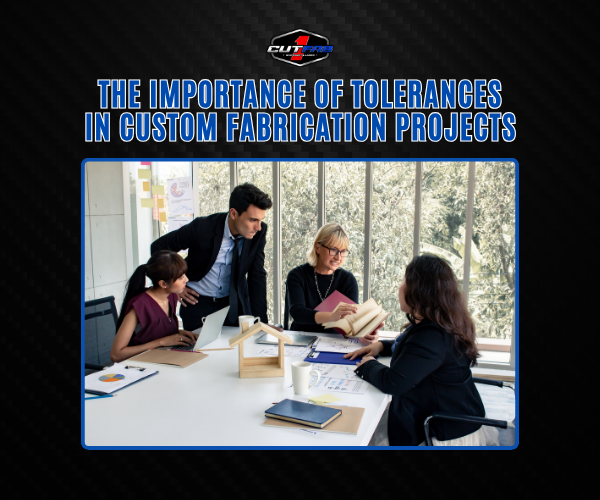
The Importance of Tolerances in Custom Fabrication Projects!
In custom fabrication, precision isn’t a luxury—it’s a necessity. Whether you're building a metal frame, a machine part, or a structural component, even the slightest deviation can lead to serious performance issues. That’s where fabrication tolerances come in. But what are fabrication tolerances, and why do they matter so much? In this article, fabrication tolerances are explained in detail so you can understand how they impact project quality, fit, and function. If you're involved in manufacturing or custom builds, mastering this concept can save you time, money, and costly mistakes down the line.
Common Tolerance Standards in Laser & Waterjet Cutting
When it comes to custom fabrication, two of the most precise methods in the industry are laser cutting and waterjet cutting. Both are known for their accuracy, but understanding the tolerance standards they can achieve is essential for avoiding costly surprises during production. Here’s where fabrication tolerances explained becomes more than just a phrase—it’s your roadmap to perfect parts.
Laser Cutting Tolerances
Laser cutting is ideal for producing intricate shapes and fine details. Most modern CNC laser machines can achieve tolerances of ±0.003" to ±0.010" (0.076mm to 0.254mm), depending on material type, thickness, and machine calibration. Thin sheets of stainless steel or aluminum will yield tighter tolerances, while thicker or more reflective materials (like copper) may require a looser margin.
Waterjet Cutting Tolerances
Waterjet cutting, which uses a high-pressure stream of water mixed with abrasive particles, delivers excellent results without introducing heat (no HAZ—Heat Affected Zone). Typical tolerances for abrasive waterjet cutting fall within ±0.005" to ±0.030" (0.127mm to 0.762mm). While not as tight as laser cutting, waterjets excel with thicker materials and complex composites.
Understanding these baseline standards helps engineers, designers, and fabricators make better decisions early in the project. After all, fabrication tolerances explained in context means fewer production issues, lower costs, and better overall outcomes.
How Tight is Too Tight?
In fabrication, tighter tolerances are often seen as a badge of quality. But here’s the catch: chasing ultra-precise tolerances can quickly backfire. So how tight is too tight? That depends on the function, fit, and cost expectations of your project.
A common misconception is that tighter always means better. While it’s true that precision matters, unnecessarily strict tolerances can complicate production, slow down turnaround times, and dramatically increase fabrication costs. For instance, moving from a tolerance of ±0.010" to ±0.001" might require a completely different setup, higher-end machines, and added inspection steps—sometimes doubling or tripling the cost without adding real value.
The key takeaway? Only specify tolerances as tight as the application truly demands.
Over-engineering Pitfalls
Over-engineering is a silent budget killer in fabrication. Engineers often fall into the trap of setting ultra-tight tolerances “just to be safe,” especially if they’re not entirely sure what the part will face in the field. The result? Parts become harder to produce, fitment issues arise due to overly rigid specs, and costs escalate fast.
Understanding the application is critical. Are parts going to be welded? Will there be post-processing like bending or coating? When fabrication tolerances are explained within the real-world context of use, it becomes easier to set specs that balance precision with practicality.
Tolerance Impact on Time and Cost
When it comes to custom fabrication, tolerance decisions don’t just affect how a part fits—they directly influence your project’s timeline and budget. In fact, many delays and budget overruns stem from tolerances that are either too tight or misunderstood. Here’s where having fabrication tolerances explained properly can save you thousands.
Tighter tolerances often demand advanced machinery, more tool changes, slower cutting speeds, and additional quality control. Each of these adds time to production and labor to your invoice. For example, holding a tolerance of ±0.002” instead of ±0.010” might sound minor on paper—but in practice, it could mean 3x the machining time and custom fixture setups.
Conversely, looser tolerances can speed things up and cut costs, but only when they still align with the functional requirements of the part. The balance lies in defining what truly matters: critical dimensions should be tight, non-essential features can remain flexible.
Put simply, tolerances are cost levers. When fabrication tolerances are explained early in the design process, smarter decisions follow—and that translates to faster delivery and better ROI.
Examples of Smart Tolerance Design
The best fabrication projects aren’t just well-built—they’re well-thought-out. Smart tolerance design means applying precision only where it matters most, without overcomplicating the entire build. To make fabrication tolerances explained in real-world terms, let’s break down a few examples.
Example 1: Mounting Holes vs. Outer Profile
In a custom steel bracket, the mounting holes must align perfectly with pre-drilled components, requiring tight tolerances of ±0.005". But the outer profile of the bracket, which has no functional impact, can be cut with a looser ±0.030" tolerance. This ensures the bracket performs as intended without wasting time or cost on non-essential details.
Example 2: Aesthetic Panels
For decorative aluminum panels, visual appeal is critical—but extreme precision often isn’t. Designers might specify ±0.020" for visible cutouts while allowing ±0.050" on hidden edges. The result? Beautiful panels that are faster and cheaper to produce.
Smart tolerance design is about prioritizing function over perfection. When fabrication tolerances are explained with specific use cases, teams collaborate better, reduce revisions, and keep projects moving forward efficiently.
Conclusion
In custom fabrication, tolerances aren’t just numbers—they’re strategic decisions that affect performance, cost, and delivery time. From laser-cut parts to waterjet components, understanding how to set realistic tolerances is key to avoiding over-engineering and unnecessary expenses. When fabrication tolerances are explained clearly from the start, teams make smarter choices, reduce waste, and build with confidence. Whether you're a designer, engineer, or manufacturer, knowing when “good enough” is truly good enough can mean the difference between a smooth project and a costly mistake.
